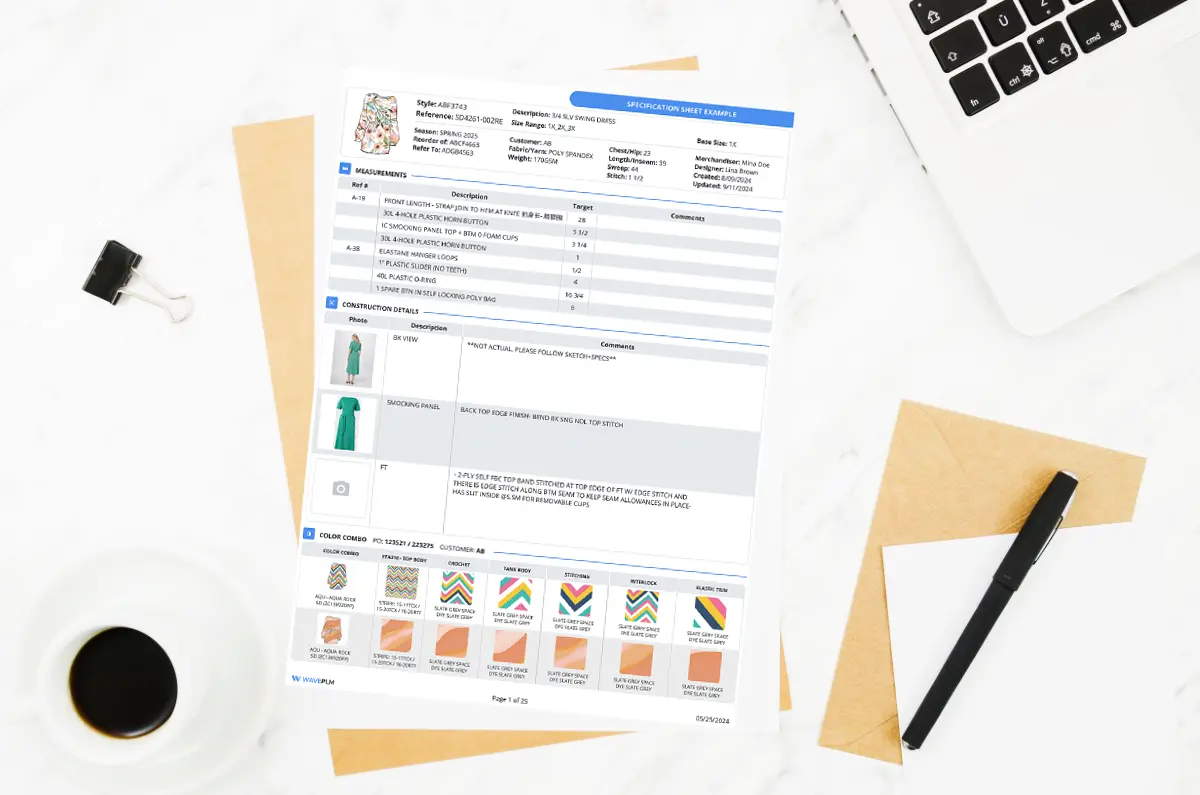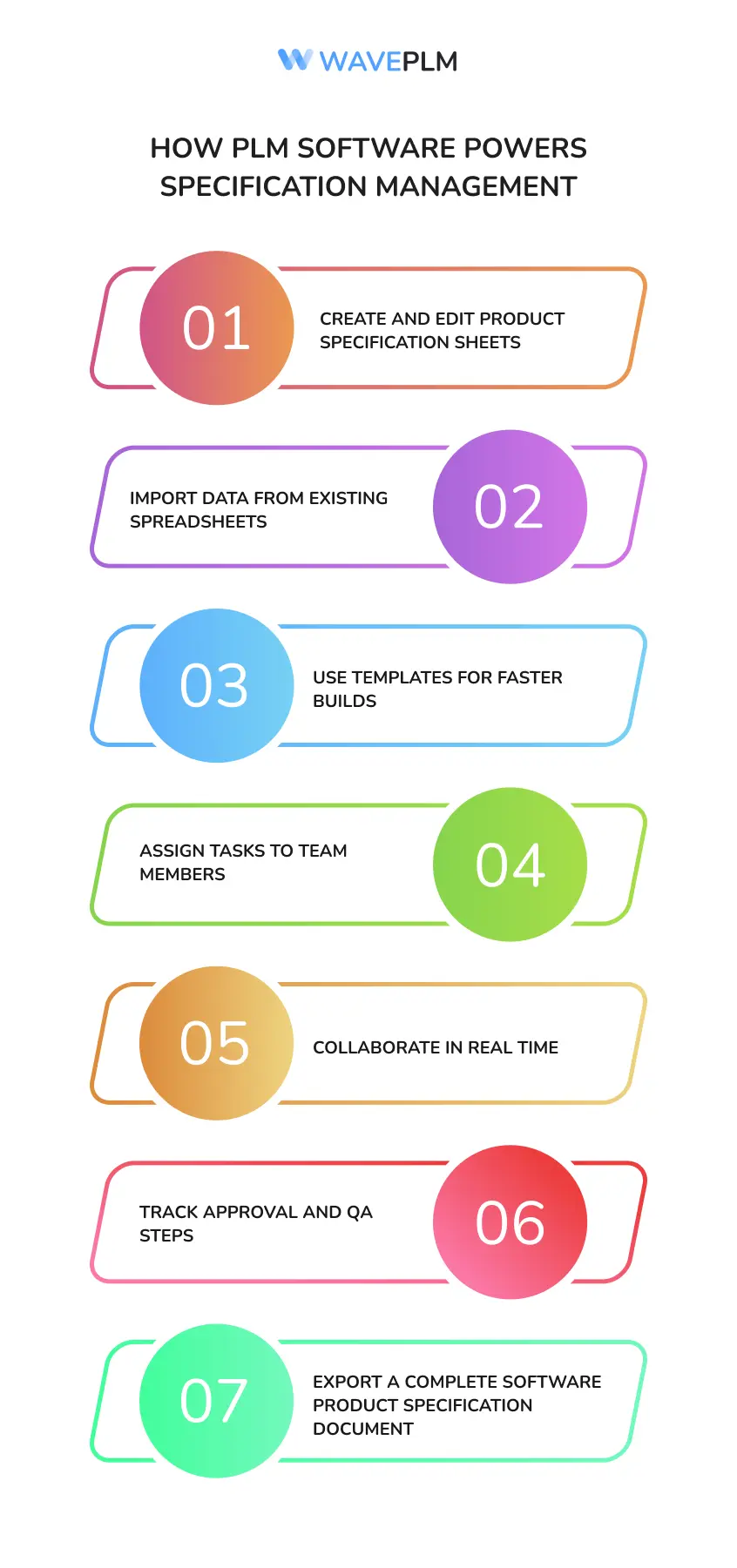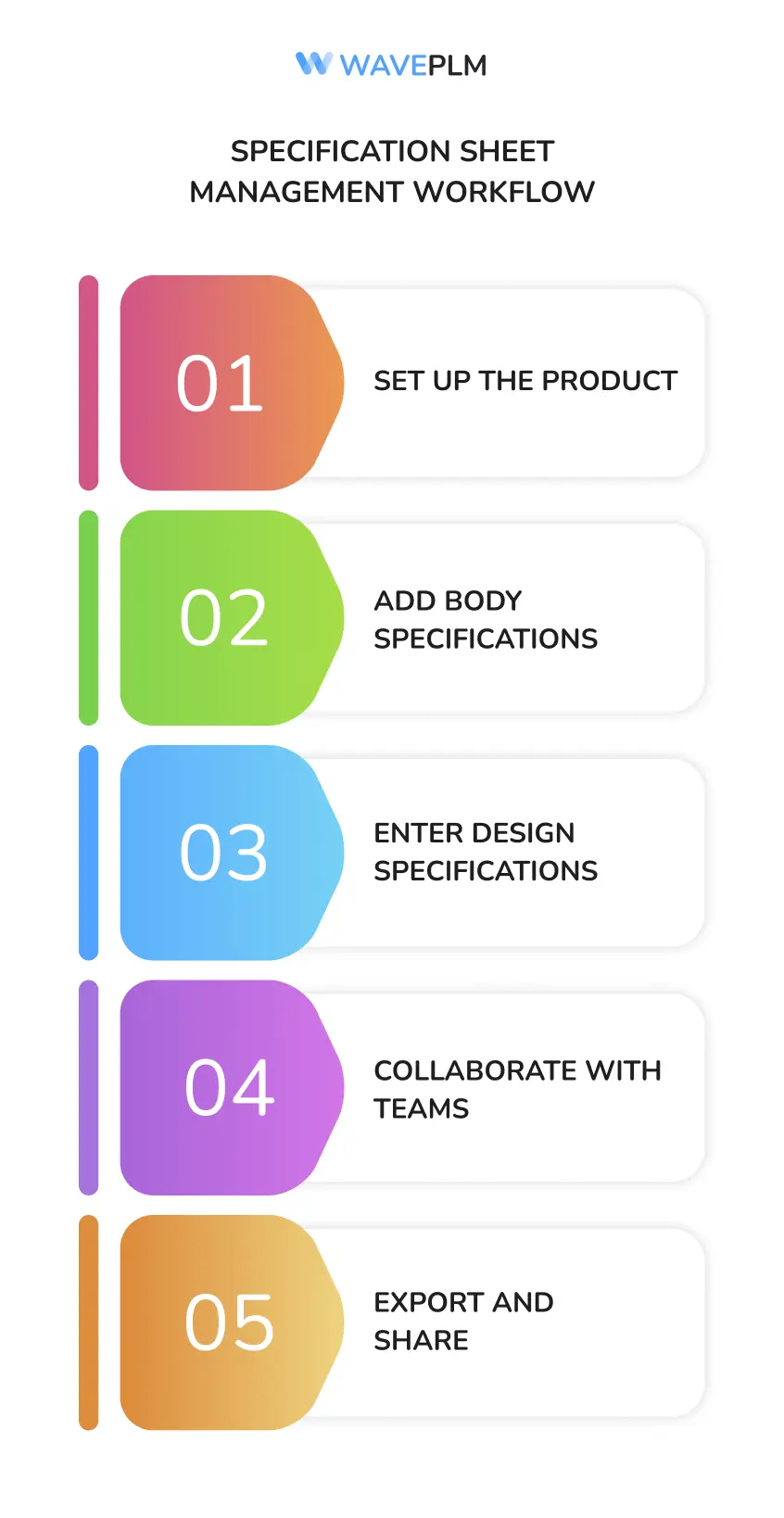
In fashion, precision is everything. A wrong measurement or unclear spec can lead to poor fits, wasted materials, and production delays. That’s why specification sheet management is a must in every fashion brand’s workflow.
This article explains how teams use product specification software to manage body specifications, design specifications, and production information. You’ll learn how Wave PLM helps brands streamline workflows with specification management software, so every product specification sheet stays accurate and accessible from day one.
What Is a Specification Sheet?
A specification sheet (or “spec sheet”) is a document that contains all the technical details needed to create a product. In fashion, it usually includes:
- Body specifications (bust, waist, hips, etc.)
- Design specifications (style, fit, fabric, trims)
- Functional requirements (pockets, closures, stretch)
- Production information (materials, colorways, labels)
- Quality control checkpoints
These sheets act as the single source of truth during development. Everyone from designers to production teams refers to it.
Why Fashion Brands Use Specification Management Software
Managing specs across Excel sheets and emails leads to errors and confusion. With digital tools like specification software, brands avoid this mess. Here’s why:
| Feature | Benefit |
|---|---|
| Centralized data | One platform for all product specs |
| Real-time updates | Teams see changes instantly |
| Collaboration tools | Designers, techs, and suppliers stay aligned |
| Templates | Speeds up spec sheet creation |
| Version control | Track changes and maintain accuracy |
Specification management software helps development teams and project managers stay on track and save time. It also improves quality assurance and collaboration.
The Role of Body Specifications
Body specifications are the base of any garment. They define how the piece should fit and feel. Without accurate body measurements, even the best designs fail.
A sample specification sheet often starts with size charts and standard measurements. These numbers guide pattern making, grading, and sizing across regions.
Example: Women’s Top Body Specifications
| Measurement Point | XS | S | M | L | XL |
|---|---|---|---|---|---|
| Bust (cm) | 84 | 88 | 92 | 96 | 100 |
| Waist (cm) | 66 | 70 | 74 | 78 | 82 |
| Hip (cm) | 90 | 94 | 98 | 102 | 106 |
Using specification management software, these values are embedded into each product specification sheet, so everyone works from the same data.

What’s Inside a Product Specification Sheet?
A software product specification document in fashion includes many parts. Here’s what goes into a standard product specification sheet in PLM:
| Section | Content |
|---|---|
| General Info | Product code, name, style, category |
| Body Specs | Measurement charts by size |
| Materials | Fabric, trims, labels |
| Technical Sketches | Front, back, side views |
| Construction Notes | Stitching, seams, finishing |
| Colorways | Approved color palettes |
| Fit Notes | Adjustments and tolerance levels |
| QA Checks | Points of measurement, pass/fail ranges |
You can create a software product specification template to repeat this structure across new collections.
Software Product Specification Template (Fashion Example)
Here’s a simplified software product specification example for a women’s dress:
| Field | Example |
|---|---|
| Product Name | Linen Midi Dress |
| Product Code | WDR-LIN-203 |
| Fabric | 100% Linen, 140 GSM |
| Trim | Wooden buttons, invisible zipper |
| Size Range | XS to XL |
| Bust (M) | 92 cm |
| Waist (M) | 74 cm |
| Hip (M) | 98 cm |
| Colorways | Natural, Olive, Rust |
| QA Checks | Bust ± 1.5 cm, Zipper function, Seam strength |
With specification management software, you can build this in minutes using drag-and-drop fields.
How PLM Software Powers Specification Management
PLM software like Wave PLM connects specification sheets to the full product lifecycle. You manage everything from user stories to product design and production with one tool.
What You Can Do in Wave PLM:
✅ Create and edit product specification sheets
✅ Import data from existing spreadsheets
✅ Use templates for faster builds
✅ Assign tasks to team members
✅ Collaborate in real time
✅ Track approval and QA steps
✅ Export a complete software product specification document
This creates a high level of control across teams and improves transparency across the supply chain.

Specification Sheet Management Workflow
Let’s break down how a team uses Wave PLM from concept to launch.
Step 1: Set Up the Product
- Define the style, season, and category
- Add general product info
Step 2: Add Body Specifications
- Choose or upload body size charts
- Set tolerance levels
Step 3: Enter Design Specifications
- Upload technical drawings
- Add construction notes
Step 4: Collaborate with Teams
- Assign tasks to team members
- Use comments to resolve issues
- Keep all versions in one place
Step 5: Export and Share
- Generate a software product specification document
- Share with suppliers and QA teams
- Ensure quality assurance before production

Benefits for the Whole Team
Everyone in the development team benefits from using specification management software:
| Role | Benefit |
|---|---|
| Designers | Create specs faster with templates |
| Pattern Makers | Use exact body measurements |
| QA Teams | Perform accurate fit checks |
| Project Managers | Track approvals and timelines |
| Manufacturers | Receive clear instructions |
Why It Matters
In fashion, details make or break a launch. Bad specs cause sizing issues, delays, and waste. Good specs lead to happy customers, smooth production, and a strong reputation.
Using a digital specification software removes guesswork. It brings structure, clarity, and speed to managing products. It aligns every stakeholder—from the sketch pad to the sewing floor.
Final Thoughts
A well-made specification sheet is not just a form—it’s a foundation. It ties together body specifications, design specs, and functional requirements into one trusted source.
Product specification software like Wave PLM helps brands meet the industry standard for fit, quality, and communication. It helps teams save time, improve collaboration, and reduce costly errors.
Whether you’re designing the next trend or scaling a collection, having strong specification management in place is key. And with the right tool, it’s easier than ever.
Try Wave PLM
✅ Build a sample specification sheet
✅ Import your software product specification template
✅ Keep your development teams aligned
✅ Launch products faster and smarter
👉 Request a demo today to see how specification management software can transform your process.





Leave a Reply